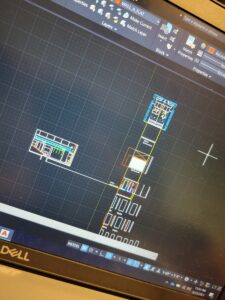One of our projects in Technical Direction was the Team Project. This project revolves around the play “A Bandaged Place.” This project had two parts. In the first part we read the play, provided AutoCAD drawings of the flats and platforms & did budget estimates. In order to do the AutoCAD drawings, we had to know how theatrical flats were built and we had to know the numerous kinds of platforms we could build. When it came to drafting the flats, around the same time during the semester we had an in-person lab about how flats were made. In that lab we stood the flats up, bolted them together, and screwed them down to hold them in place. I didn’t exactly understand the problem correctly on my first try but using that knowledge of how flats are built helped in drafting them in CAD. Our time away from in person classes called for a reminder on the lumber it took to build flats such as the rails and the toggles. As it pertains to the budget, however, we had to do a bit more research based on the information that the drawings gave us. There were specific types of paints and a wall covering as well as a specific type of glass for the windows. The initial research was the hardest part but we just had to keep looking until we found the specific products listed. As we found certain products we used the same / similar websites to aid us in finding more of the materials we needed. Part one was a little bit challenging but became easier as we did the work.
In part two of the team project, we had to add a labor estimate, build calendar, a load-in plan and a strike plan. In this part of the team project, I was responsible for the material estimate, load-in and strike plan. Although, I did help with other aspects of the project. Thanks to the labs we did throughout the semester, I was able to have a better, solution-oriented approach to these tasks. One small issue was making sure that none of the fine detailing was left out when it came to the load-in and the strike because it was so easy to overlook because the minor steps, we tend to know by second nature given our experience. But when communicating the steps in the load-in/strike, it is imperative that the fine details in and between each step is mentioned. The main issue was regarding finding the price of lumber. Later on during the semester, my partner Jeoffery referred me to a lumber company that showed their prices for various pieces of lumber. This made the material estimate process a lot easier.
In comparison to real world situations, loading and striking the scenic elements of a play in a live show such as Broadway, not only would the steps have to be described in detail, but the process would have to be done in a timely fashion which is why a build calendar was a necessary part of this task. There would also most likely be drawings already drafted for those of us that were not working as scenic designers. On top of that, there would’ve been more experienced people helping out in getting the problems solved faster. We would have known where to look to find paints, lumber, flooring, etc. ENT 4410-TD Team Project 1 (1)
ENT 4410-TD Team Project 1 (1)


